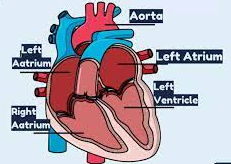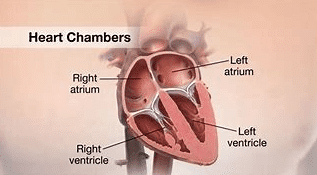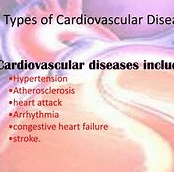Human heart: Structure, Function and Diseases
 The human heart, a marvel of biological engineering, serves as the relentless orchestrator of our circulatory system. Nestled within the protective confines of the chest, this muscular organ, roughly the size of a fist, tirelessly pumps life-sustaining blood throughout the body.
The human heart, a marvel of biological engineering, serves as the relentless orchestrator of our circulatory system. Nestled within the protective confines of the chest, this muscular organ, roughly the size of a fist, tirelessly pumps life-sustaining blood throughout the body.
Human Heart Chambers

Comprising four chambers—two atria and two ventricles—the heart operates with rhythmic precision, orchestrated by the synchronized contractions and relaxations of its muscular walls. The right atrium welcomes deoxygenated blood returning from the body, propelling it into the right ventricle, which then dispatches it to the lungs for revitalization. Oxygen-rich blood, having completed its pulmonary pitstop, returns to the left atrium before surging into the left ventricle. The left ventricle’s robust contractions propel this oxygenated blood into the systemic circulation, nourishing organs and tissues.
Integral to this cardiovascular symphony is the heart’s valves—meticulously calibrated gatekeepers that ensure unidirectional blood flow. The tricuspid and mitral valves separate the atria from the ventricles, while the pulmonary and aortic valves govern the exits to the lungs and the body, respectively.
Beyond its mechanical prowess, the heart carries emotional significance, often symbolizing love and vitality in cultural and artistic realms. While its physiological role is paramount, the human heart transcends its biological duties, resonating as a potent emblem of life’s pulsating rhythm.
Structure of Human heart:
The human heart has four chambers: two atria (left and right) and two ventricles (left and right). Blood enters the right atrium from the body, flows to the right ventricle, and is pumped to the lungs for oxygenation. Oxygenated blood returns to the left atrium, moves to the left ventricle and is then pumped out to the rest of the body. The heart is a vital organ, orchestrating this circulatory system with rhythmic contractions.
The heart is a muscular organ positioned slightly left of the center in the chest. It is enclosed in a double-walled sac called the pericardium. The walls of the heart are made up of three layers: the epicardium (outer layer), myocardium (middle layer, responsible for contraction), and endocardium (inner layer).
Heart contractions
The heart’s contractions, or heartbeats, are regulated by electrical impulses. The sinoatrial (SA) node initiates the impulse, causing the atria to contract. The atrioventricular (AV) node then relays the impulse to the ventricles, prompting their contraction. This synchronized action maintains an efficient blood flow.
Heart valve:
The heart valves play a crucial role in ensuring unidirectional blood flow. The tricuspid valve separates the right atrium and ventricle, while the bicuspid or mitral valve separates the left atrium and ventricle. The pulmonary valve guards the entrance to the pulmonary artery, and the aortic valve regulates blood flow into the aorta.
This intricate system ensures that oxygenated and deoxygenated blood do not mix, providing the body with the necessary oxygen and nutrients while removing waste products. The heart’s constant, rhythmic activity is essential for sustaining life.
Functions of Human Heart
The human heart serves as a vital organ, with several crucial functions. It pumps blood throughout the circulatory system, delivering oxygen and nutrients to cells while removing waste products. The atria receive deoxygenated blood and oxygenated blood from the body and lungs, respectively. The ventricles then pump this blood to the lungs and the rest of the body. The heart also maintains blood pressure, ensuring a continuous flow. Its rhythmic contractions, controlled by electrical signals, regulate the cardiac cycle. Overall, the heart’s intricate functions are essential for sustaining life.
1:Pumping Blood
The heart is a muscular pump responsible for circulating blood throughout the body.
2. Receiving Blood:
The right atrium receives deoxygenated blood from the body, while the left atrium receives oxygenated blood from the lungs.
3. Ventricular pumping
The heart has two ventricles (left and right) that contract to pump blood to the lungs and the rest of the body.
4. Oxygen delivery
Oxygenated blood is pumped to cells, providing them with the oxygen necessary for cellular functions.
5. Nutrient transport
Alongside oxygen, the blood carries essential nutrients to various tissues and organs.
6. Waste removal
Deoxygenated blood, carrying waste products, is pumped to the lungs and kidneys for oxygenation and filtration.
7. Blood pressure Regulation
The heart maintains blood pressure, ensuring a continuous and controlled flow of blood through the arteries and veins.
8. Electrical Control:
The heart’s contractions are regulated by electrical signals, ensuring a rhythmic cardiac cycle.
9. Circulatory system support:
The heart works in tandem with blood vessels to form the circulatory system, facilitating nutrient and gas exchange.
10. Life sustaining:
The heart’s efficient functioning is crucial for sustaining life, making it a cornerstone of the human cardiovascular system.
List of Human Heart Diseases
- Coronary artery disease (CAD)
- Heart failure
- Arrhythmias
- Valvular heart diseases
- Cardiomyopathy
- Congenital heart defects
- Myocardial infarction (heart attack)
- Hypertension (high blood pressure)
- Atherosclerosis
- Pericardial diseases
1. Coronary Artery disease(CAD):
A condition where the blood vessels supplying the heart muscle narrow or become blocked, leading to reduced blood flow and oxygen to the heart, often causing chest pain or heart attacks.
2. Heart failure:
This occurs when the heart is unable to pump blood effectively, resulting in fatigue, shortness of breath, and fluid retention. It can be caused by various conditions, including CAD and hypertension.
3. Arrhythmias:
Irregular heartbeats can manifest as tachycardia (fast heart rate), bradycardia (slow heart rate), or atrial fibrillation. They can disrupt the normal rhythm and coordination of the heart.
4.Valvular Heart Diseases:
Conditions affecting heart valves, such as stenosis (narrowing) or regurgitation (leaking), compromise the heart’s ability to pump blood efficiently.
5. Cardiomyopathy:
Diseases of the heart muscle, lead to weakened pumping ability. Types include dilated, hypertrophic, and restrictive cardiomyopathy.
6. Congenital Heart Defects:
Structural abnormalities present at birth, affect the heart’s chambers, valves, or blood vessels. These defects can disrupt normal blood flow.
7. Myocardial Infarction (Heart Attack):
Occurs when blood flow to a part of the heart is blocked, leading to damage or death of the heart muscle. Symptoms include chest pain, shortness of breath, and sweating.
8. Hypertension (High Blood Pressure):
Prolonged elevation of blood pressure, straining the heart and blood vessels. It’s a significant risk factor for other heart-related conditions.
9. Atherosclerosis:
Buildup of plaque in the arteries, narrowing them and reducing blood flow. It is a key factor in CAD and can lead to heart attacks and strokes.
10. Pericardial Diseases:
Conditions affecting the pericardium, the sac around the heart. This includes pericarditis (inflammation) and pericardial effusion (fluid accumulation), impacting heart function.
Test for determining heart diseases
here are some important tests for determining heart problems.
Tests to determine heart diseases may include:
- an electrocardiogram (ECG or EKG)
- stress test
- echocardiogram
- blood tests (lipid panel)
- and coronary angiography.
Note: It’s crucial to consult a healthcare professional for personalized advice.